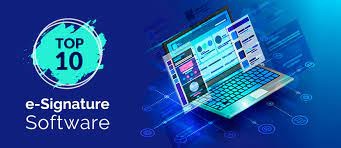In today's digital era, the landscape of traditional paperwork and physical signatures is rapidly transforming. Electronic signature software has emerged as a critical tool, revolutionizing the way we sign and authenticate documents. This article delves into the realm of electronic signature software, highlighting its features, applications, and impact on modern workflows.
Understanding Electronic Signature Software
Electronic signature software is a digital tool that facilitates the signing of documents without the need for physical signatures. It allows users to sign documents electronically, providing a legal and secure alternative to traditional signatures. These software solutions offer various methods to sign documents, ensuring authenticity and compliance with legal standards.

Features of Electronic Signature Software
Utilizes advanced encryption techniques to secure documents and signatures.
Complies with legal regulations and industry standards to ensure the legality and admissibility of electronic signatures.
User Authentication:
Implements multi-factor authentication (MFA) and biometric authentication to verify the identity of signers.
Enhances security by requiring unique passwords or codes for access.
Allows customization of document templates to align with specific business needs.
Provides predefined templates to streamline the signing process for commonly used documents.
Integrates with various business applications like CRM systems, cloud storage, and project management tools.
Offers workflow automation, enabling smooth document routing and approval processes.
Provides mobile applications or responsive designs for signing on the go, enhancing accessibility and convenience.
Creates a detailed audit trail, tracking all activities related to a document, including viewing and signing.
Enables tracking of document status, notifying stakeholders about the progress of signatures.
Applications of Electronic Signature Software
Business Agreements and Contracts:
Facilitates the signing of business contracts, partnership agreements, and vendor contracts, expediting deal closures.
Human Resources and Employee Onboarding:
Simplifies the signing of employment contracts, non-disclosure agreements, and other HR-related documents during employee onboarding.
Financial Transactions:
Streamlines financial processes, including loan approvals, investment agreements, and account openings, ensuring efficient and secure transactions.
Legal Documentation:
Enables the signing of legal documents such as pleadings, court filings, and client agreements, enhancing efficiency in legal processes.
Healthcare Records and Compliance:
Supports the signing of medical consent forms, patient records, and compliance agreements, ensuring confidentiality and compliance with healthcare regulations.
Conclusion
Electronic signature software has become an integral part of modern business operations, offering a secure, efficient, and legally recognized method for signing and authenticating documents. As the digital landscape continues to evolve, electronic signature software is expected to advance further, providing even more secure and seamless solutions. Embracing this technological shift is essential for businesses and individuals seeking to optimize workflows, reduce paperwork, and stay compliant with legal standards.